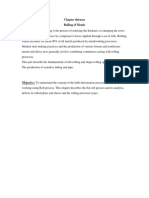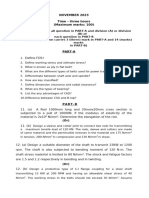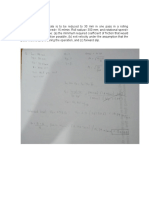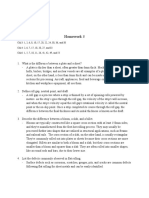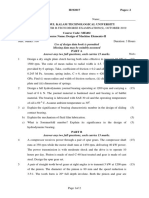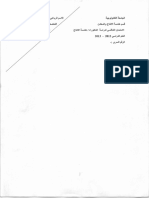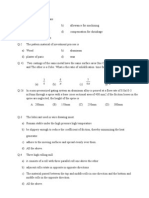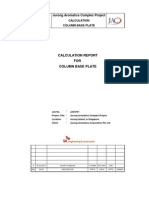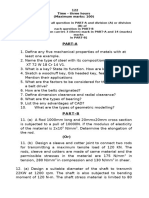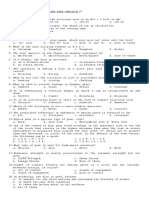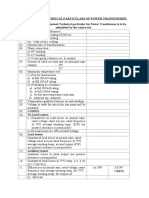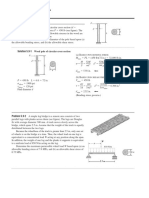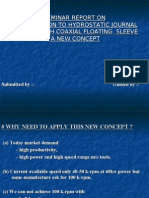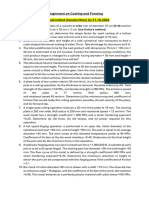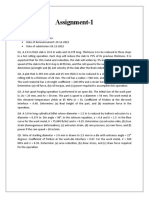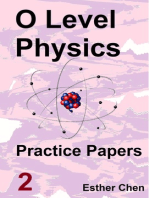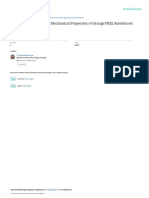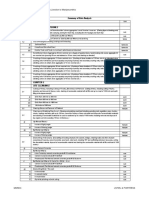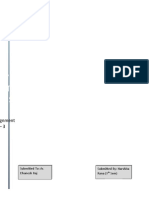HW 2
HW 2
Uploaded by
kmwmjbrn8yCopyright:
Available Formats
HW 2
HW 2
Uploaded by
kmwmjbrn8yOriginal Title
Copyright
Available Formats
Share this document
Did you find this document useful?
Is this content inappropriate?
Copyright:
Available Formats
HW 2
HW 2
Uploaded by
kmwmjbrn8yCopyright:
Available Formats
HW-2
Q1: Name the four basic bulk deformation processes.
Q2: Identify some of the ways in which force in flat rolling can be reduced.
Q3: The starting workpiece in steel hot rolling of plate and sheet stock is which of the
following: (a) bar stock, (b) billet, (c) bloom, (d) slab, or (e) wire stock?
Q4: The maximum possible draft in a rolling operation depends on which of the
following parameters: (a) coefficient of friction between roll and w.p. and roll radius,
(b) roll velocity, (c) original w.p. thickness, (d) strain, and (e) strength coefficient of
the work metal?
Q5: Which of the following stress or strength parameters is used in the computation
of cold rolling force: (a) average flow stress, (b) compression strength, (c) final flow
stress, (d) tensile strength, or (e) yield strength?
Q6: A 42.0-mm-thick plate made of low carbon steel is to be reduced to 34.0 mm in
one pass in a rolling operation. As the thickness is reduced, the plate widens by 4%
(wf=1.04wo). The entrance speed of the plate (vo) is 15.0 m/min. The roll radius is 325
mm and the rotational speed is 8.0 rev/min. Determine (a) the minimum required
coefficient of friction that would make this rolling operation possible, (b) exit
velocity of the plate (vf), and (c) forward slip.
Q7: A hot rolling mill has rolls of diameter = 24 in. It can exert a maximum force =
400,000 lb. The mill has a maximum horsepower = 100 hp. It is desired to reduce a
1.5-in thick plate (to) by the maximum possible draft in one pass. The starting plate is
10 in wide (wo=wf). In the heated condition, the work material has a strength
coefficient (K) = 20,000 lb/in2 and a strain-hardening exponent (n) = zero. Determine
(a) maximum possible draft, (b) true strain, and (c) maximum speed of the rolls in
rpm (N) and ft/min (vr).
Hint: (1) dmax = d , (2) use the average flow stress in the calculations.
1hp=396000 (in-Ib/min)
1ft=12in
Q8: A single-pass rolling operation reduces a 20 mm thick plate to 18 mm. The
starting plate is 200 mm wide (wo=wf). Roll radius = 250 mm and rotational speed =
12 rev/min. The work material has a strength coefficient = 600 MPa, a strain-
hardening exponent = 0.22 and a coefficient of friction = 0.11. Determine (a) is this
rolling process feasible? If so, then calculate (b) roll force, (c) roll torque, and (d)
power required for this operation.
Q9: A series of cold rolling operations are to be used to reduce the thickness of a
plate from 50 mm down to 25 mm. Roll diameter = 700 mm and coefficient of
friction between rolls and w.p. = 0.15. The specification is that the draft is to be equal
on each pass. Determine (a) number of passes required, and (b) draft for each pass.
Q10: for the flat rolling process, show that:
1- Maximum Possible Draft: 𝒅𝒎𝒂𝒙 = 𝝁𝟐 𝑹
2- Contact length: 𝐋 = √𝐑𝐝
Q11: How the detrimental effects of residual tensile stresses can be reduced?
Q12: How can slipping and friction occur between rolls and w.p. in rolling processes?
Q13: Why Ff left > Ff right always and location of the neutral point should be toward the
exit zone?
Q14: What are the main reasons to arise the residual stresses?
Q15: Why the surface finish of w.p. in cold rolling is better than in hot rolling?
Q16: Why the w.p. in cold rolling is strengthened?
Q17: In hot rolling, what are the consequences of sticking if occurred?
Q18: In rolling processes, at any condition it can be consider that the increase in width
of w.p. is not important?
Q19: Why the volume rate of w.p. flow is constant through the rolling processes?
You might also like
- Dubai Municipality Exam STEEL G+1 and G+4 UpdatedNo ratings yetDubai Municipality Exam STEEL G+1 and G+4 Updated20 pages
- Pmegp Flyash Bricks Project Report 4-24 PDF100% (3)Pmegp Flyash Bricks Project Report 4-24 PDF16 pages
- Electric Boiler Design Calculations-ASME SEC.I, PART-PEB, EDITION 2019 PDFNo ratings yetElectric Boiler Design Calculations-ASME SEC.I, PART-PEB, EDITION 2019 PDF48 pages
- Assignment3forming Solutions 121213110849 Phpapp02No ratings yetAssignment3forming Solutions 121213110849 Phpapp024 pages
- Manufacturing Processes For Mechanical EngineeringNo ratings yetManufacturing Processes For Mechanical Engineering21 pages
- Time Allowed: 1.5 Hours Full Marks: 70: 604 (S) August 2021No ratings yetTime Allowed: 1.5 Hours Full Marks: 70: 604 (S) August 20213 pages
- Department of Mechanical Engineering Mechanical Design &estimation (Dme-306) Question BankNo ratings yetDepartment of Mechanical Engineering Mechanical Design &estimation (Dme-306) Question Bank4 pages
- Question Paper - Design of Machine Elements 2 Oct-19-October - 2019No ratings yetQuestion Paper - Design of Machine Elements 2 Oct-19-October - 20192 pages
- Module3 IE3130 Forming and Shaping RollingNo ratings yetModule3 IE3130 Forming and Shaping Rolling28 pages
- Guaranteed Technical Particulars of Power TransformerNo ratings yetGuaranteed Technical Particulars of Power Transformer10 pages
- Design of Machine Elements Question Paper SampleNo ratings yetDesign of Machine Elements Question Paper Sample5 pages
- BARC Recruitment Exam: Previous Year PaperNo ratings yetBARC Recruitment Exam: Previous Year Paper11 pages
- L&T (ECC) Placement Paper Pattern: Section-1No ratings yetL&T (ECC) Placement Paper Pattern: Section-18 pages
- Assignment 1 Eng 221 Metal Forming Second 2023 2024No ratings yetAssignment 1 Eng 221 Metal Forming Second 2023 20243 pages
- 8d d38999 Mil-Dtl-38999 Series III PDF CatalogueNo ratings yet8d d38999 Mil-Dtl-38999 Series III PDF Catalogue152 pages
- Fabrication and Study of Mechanical Properties of Orange PEEL Reinforced Polymer CompositeNo ratings yetFabrication and Study of Mechanical Properties of Orange PEEL Reinforced Polymer Composite6 pages
- Summary of Rate Analysis Chapter-1 Carriage of MaterialsNo ratings yetSummary of Rate Analysis Chapter-1 Carriage of Materials42 pages
- Sunway Big Box Office - C&S Design Write Up 20 02 13No ratings yetSunway Big Box Office - C&S Design Write Up 20 02 133 pages
- THERMAL ANALYSIS FSW TOOL BY USING FEA MethodNo ratings yetTHERMAL ANALYSIS FSW TOOL BY USING FEA Method5 pages
- Agencies and The Building Materials Manufactured by ThemNo ratings yetAgencies and The Building Materials Manufactured by Them5 pages
- Southwire Cable in Conduit Product CatalogNo ratings yetSouthwire Cable in Conduit Product Catalog65 pages
- 03.phase Transformations in Creep Strength Enhanced Ferritic Steel WeldsNo ratings yet03.phase Transformations in Creep Strength Enhanced Ferritic Steel Welds4 pages
- 9" 2-16tor ST Stirrups 12" 2-16tor ST PB-1:9"X12": Produced by An Autodesk Student VersionNo ratings yet9" 2-16tor ST Stirrups 12" 2-16tor ST PB-1:9"X12": Produced by An Autodesk Student Version1 page
- Compressive Strength and Durability Properties of High Volume Fly Ash (HVFA) Concretes Containing Ultrafine Fly Ash (UFFA)No ratings yetCompressive Strength and Durability Properties of High Volume Fly Ash (HVFA) Concretes Containing Ultrafine Fly Ash (UFFA)14 pages
- Use of Granulated Blast-Furnace Slag in Concrete As Fine AggregateNo ratings yetUse of Granulated Blast-Furnace Slag in Concrete As Fine Aggregate6 pages







